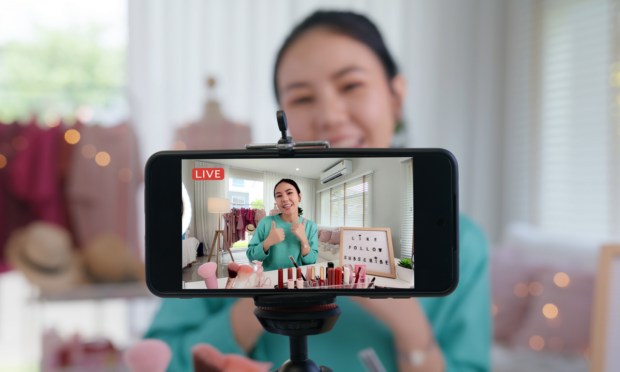Snap Enables Profile Links but Which Creators Will Convert?

With platforms like TikTok, Facebook, and Instagram making it faster and more convenient for consumers worldwide to share their shopping experiences and kick-start retail trends, Snapchat has now joined the fray.
The social media platform is working to deepen its connection with creators by enabling users to showcase their work and additional profiles on the platform through the integration of Linktree’s link-in-bio tool.
But is it a feature brands, retailers and creators will find lucrative? And which types of brands and creators will prosper on the platform?
It all depends. As the option to use such features becomes available to users with smaller followings, the outcomes will differ depending on factors such as brand, industry, follower count, and the level of engagement established by brands, retailers, or creators.
According to “Tracking the Digital Payments Takeover: Monetizing Social Media Edition,” a PYMNTS and Amazon Web Services collaboration, only 43% of consumers, some 110 million people, use social media platforms for browsing and discovering goods and services. A mere 14%, or 36 million, actually purchase those goods and services.
The report, which surveyed a census-balanced panel of 2,976 consumers in the U.S. between May 5 and May 15, provides insights into why retailers use social media to boost sales and overcome obstacles that hinder their progress. The survey aimed to understand the factors that motivate consumers to shop on social media, their preferred payment methods for transactions, and the actions merchants can take to increase conversion rates.
Purchases Linked to Social Media Channels
As per the report, different social media platforms exhibited varying levels of performance across product categories. Instagram, with its curated feed of appealing pictures, proved to be suitable for showcasing visually oriented products like clothing. In fact, 47% of consumers surveyed had purchased clothes on Instagram in the 30 days leading up to the survey, making it the platform with the highest percentage. TikTok closely followed, with 42% of its users having made clothing purchases.
Based off PYMNTS findings, social media can be bucketed into different category strengths: Instagram, clothing; TikTok, beauty; YouTube, food and beverage.
But where does Snapchat fall?
Impulse Purchases and Social Media
The convenience of transitioning from browsing to buying is a big draw for social media shopping. Among consumers who engage in transactions on social media, 32% do so because of the ease and familiarity it offers, while 28% appreciate the ability to purchase with minimal effort as soon as they are captivated by a product.
But sellers on these platforms must address certain obstacles to enhance conversion rates. One of the main challenges is a lack of trust.
Among consumers who do not engage in transactions on social media, 37% express concerns about sharing their personal data, and 31% harbor doubts about the legitimacy of the sellers. These factors stand out as top deterrents for consumers when it comes to transacting on social media.
PYMNTS research reveals additional areas where consumers exhibit skepticism regarding the merchants and products they encounter on social media.
What Snapchat’s Linktree Partnership Means
The launch represents a long-awaited progression for the social network, as it previously limited the inclusion of links in creator profiles to brands and Snap Stars — popular creators within the network.
Since its initial announcement in April, the partnership has advanced significantly, granting users with public profiles the ability to integrate links to their Linktree profiles. Snap has extended this privilege to all users 18 and older, enabling them to create a public profile and include relevant links.
Creators who use the link-in-bio tool now have the ability to showcase their Snapchat profile on their Linktree page. Linktree will receive prominent placement in Snapchat’s default share sheet, expanding its reach and visibility within the Snapchat community.
As a part of this integration, Linktree is offering users a special promotion of three months of Linktree Pro. Linktree Pro subscriptions offer additional features, including the collection of email and phone numbers, the ability to embed the latest tweets and YouTube videos, and NFT lock capabilities.
The move follows the news that Snapchat’s move to expand its revenue-sharing program for eligible creators, taking into account various factors like follower count and monthly Snap views, and has several thousand creators in it.
The platform has also introduced a Public Stories feature, allowing users to share their Stories with a broader audience beyond their followers or friends.
According to a report by The Wall Street Journal, these initiatives have gained considerable traction, capturing the interest of creators like Adam Waheed, with 12 million YouTube subscribers, who joined Snap Star in February and has since revealed that he earns a six-figure monthly income on the platform.
According to Waheed, he had been using Snapchat since its inception but had reduced his activity on the platform. However, he found himself drawn back to Snapchat and started investing more time and effort into it after joining the Snap Star program. He also observed that other creators have followed suit, increasing their engagement on the platform as well.
“I’m not going to spend any time on a platform if it’s not beneficial,” Waheed told WSJ.
Read more: Snapchat Reportedly Reaps Benefits From Creator Revenue-Sharing Program
The Linktree Momentum
Linktree is a premier link-in-bio tool for creators, continuously improving its offerings by introducing additional payment services and integrating with various social media platforms.
In the previous year, TikTok partnered with Linktree to introduce its Profile Kit, a collaboration aimed at enriching the functionality and capabilities of TikTok profiles. In January, Linktree introduced “Buy Me a Gift,” offering creators an additional means to engage with their audiences and monetize their content.

